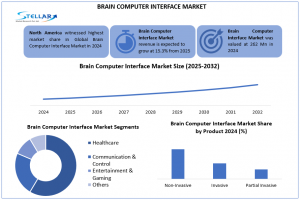Brain Computer Interface Market Expected To Reach USD 818.34 Million by 2032, Grow at a CAGR of 15.3 % From 2025 to 2032
Global Brain Computer Interface Market revenue is expected to grow at a CAGR of 15.3 % from 2025 to 2032, reaching nearly USD 818.34 Mn by 2032.
BCI refers to a technology that enables the brain to communicate with an external device. Hardware, software, and applications consist of the healthcare, gaming, and defense sectors. Aided by advances in neurotechnology and the need for assistive systems, brain-computer interfaces recognize brain signal patterns and convert them into commands without any physical movement.
Brain Computer Interface Market Overview
The Brain-Computer Interface (BCI) Market is all about creating a direct line of communication between our brains and external devices. It translates neural signals into commands, allowing us to control things without any physical movement. This technology is gaining traction, especially with the rise in neurological disorders, the growing need for assistive technologies, and the integration of AI. You can find applications in various fields like healthcare, neurogaming, the military, and smart devices. North America is at the forefront, thanks to robust research and development and major players like Neuralink and Emotiv. Non-invasive BCIs are particularly popular because they’re user-friendly. With ongoing technological advancements and increased funding, BCI development is speeding up in both medical and commercial areas.
To know the most attractive segments, click here for a free sample of the report: https://www.stellarmr.com/report/req_sample/brain-computer-interface-market/2654
Brain Computer Interface Market Dynamics
Drivers
Rising Prevalence of Neurological Disorders
The rising pace of brain problems like Alzheimer’s, Parkinson’s, epilepsy and ALS are a lot of the reason why the BCI market is getting bigger. These kinds of brain problems hurt how well you can move or think and this makes it very hard for people who need help. BCIs help people who are very sick to talk or move. People may have what is called the locked-in syndrome and they may not be able to do anything at all. BCIs work by reading brain signals and giving commands to speech, machines, or move. This lets people be more free, have a better life, and get better care done.
Advancements in Neurotechnology
Advancements in neurotechnology are driving the Brain-Computer Interface (BCI) market through miniaturized, high-resolution sensors that enable less invasive, more comfortable brain signal monitoring. These compact systems, paired with powerful machine learning and AI algorithms, enhance signal accuracy and adaptability. AI enables real-time pattern recognition and personalized user experiences, expanding BCI applications from clinical therapies to gaming, mental health, and cognitive monitoring, making BCIs more accessible, efficient, and commercially viable across industries.
Restraints
High Cost of BCI Systems
Brain-Computer Interface (BCI) systems are very costly and this is mainly because of the use of the latest hardware, custom software and the calibration process. The costs are even higher because of high research and development costs, the need for clinical validation and professional approval. Medical grade BCIs need to go through a long process of testing and accreditation procedures. Because of this, they are very expensive and this makes it hard to use them widely in hospitals, research centers or in defense systems where they are used in very small numbers and not in the consumer market unless there will be a change in the way they work and how much they cost to make and keep working.
Innovation and Development
Technological innovation is a key factor propelling the Brain Computer Interface Market forward. Notable advancements include:
Miniaturization and Wearable BCI Devices: Miniature and wearable brain–computer device (BCI) systems that are run by new types of small, light, and flexible parts, new types of small and light parts that can work with the body, and new types of small and light parts that can work on their own can help watch the brain. These small and light systems will help make BCI work for people in the world of today for things that help mental health, games, and work. They will help more people use BCI, and be easier for people to use, and make BCI work better for people to use.
Neurofeedback and Cognitive Enhancement: BCI tools play a significant role in neurofeedback, aiding in mental health therapy, meditation, stress relief, and cognitive training. These devices keep an eye on brain activity in real time, allowing users to boost their focus, emotional regulation, and mental clarity through tailored feedback, all while fostering overall wellness.
Brain Computer Interface Market Segmentation
By Product
Based on Product, the Brain Computer Interface Market is segmented into Non-Invasive, Invasive, and Partial Invasive. Non-invasive brain-computer interfaces (BCIs) are leading the charge in the BCI market, making up more than 65% of global revenue thanks to their safety, affordability, and user-friendliness. Unlike their invasive counterparts that require surgery, non-invasive options like EEG headsets have found a home in healthcare, gaming, and wellness sectors. Recent advancements in dry electrodes and artificial intelligence have boosted their accuracy, while fewer regulatory hurdles have paved the way for quicker adoption. Their lower price point and broad appeal are driving increased usage in both clinical settings and among everyday consumers.
To know the most attractive segments, click here for a free sample of the report: https://www.stellarmr.com/report/req_sample/brain-computer-interface-market/2654
Brain Computer Interface Market Regional Analysis
North America: North America is in charge of the BCI market, with over 40% of the work. This is because of a strong tool to do research and find new things, high costs for health care, over $12,000 for every person in the U.S., and the fact that there are many top firms like Neuralink and Emotive. Bodies of the government like DARPA and NIH give a lot of money to neurotechnology programs, and the fact that there are many more diseases of the brain in the old people, which makes what we need. Additionally, supportive FDA regulations and the early adoption of technology are further solidifying the region's market leadership.
Europe: Europe is the second-biggest market for Brain-Computer Interfaces (BCI). It has more than 150 big research groups and has had over €200 million in EU funds. With many older people, BCIs are on the rise. The field has big names like g.tec from Austria and Bitbrain from Spain. Today, there are over 30 trials in the works. In the face of new rules, Europe can now use BCIs in health, help people get back on their feet, and in other ways to help.
Brain Computer Interface Market Competitive Landscape
The global and regional players in the Brain Computer Interface Market concentrate on developing and enhancing their capabilities, resulting in fierce competition. Notable players include:
Neuralink (US)
Synchron (US)
Paradromics (US)
Precision Neuroscience (US)
Emotiv (US)
Comind (UK)
Clinatec (France)
CereGate (Germany)
Brainlab (Germany)
Starmind (Switzerland)
NeuroXess (China)
Nihon Kohden (Japan)
NeuroLeap (India)
CureMetrix (India)
BrainLink (South Korea)
Cerebra Health (South Africa)
Neurointelligence (UAE)
Brain Click LLC (UAE)
Brainwave Innovations (Nigeria)
Mind matters (Egypt)
Neurobots (Brazil)
BRAINN (Brazil)
Asteroid Technologies (Argentina)
GIRAB (Peru)
The Able Gaming Lab (Chile)
Related Reports:
Hyperpigmentation Treatment Market: https://www.stellarmr.com/report/hyperpigmentation-treatment-market/2468
Dermal Fillers Market: https://www.stellarmr.com/report/dermal-fillers-market/2455
Blockchain Healthcare Market: https://www.stellarmr.com/report/blockchain-healthcare-market/2451
Acne Treatment Market: https://www.stellarmr.com/report/acne-treatment-market/2448
Inpatient Services Market: https://www.stellarmr.com/report/inpatient-services-market/2447
About Stellar Market Research:
Stellar Market Research is a multifaceted market research and consulting company with professionals from several industries. Some of the industries we cover include medical devices, pharmaceutical manufacturers, science and engineering, electronic components, industrial equipment, technology and communication, cars and automobiles, chemical products and substances, general merchandise, beverages, personal care, and automated systems. To mention a few, we provide market-verified industry estimations, technical trend analysis, crucial market research, strategic advice, competition analysis, production and demand analysis, and client impact studies.
Contact Stellar Market Research:
S.no.8, h.no. 4-8 Pl.7/4, Kothrud,
Pinnac Memories Fl. No. 3, Kothrud, Pune,
Pune, Maharashtra, 411029
sales@stellarmr.com
Lumawant Godage
Stellar Market Research
+91 9607365656
email us here
Visit us on social media:
LinkedIn
Instagram
X
Legal Disclaimer:
EIN Presswire provides this news content "as is" without warranty of any kind. We do not accept any responsibility or liability for the accuracy, content, images, videos, licenses, completeness, legality, or reliability of the information contained in this article. If you have any complaints or copyright issues related to this article, kindly contact the author above.
Passive Fire Protection Market 2025–2033: Trends, Growth, Forecast, Key Applications, and Regional Insights
What people really think about the ocean: Survey results released for World Oceans Day
US Drug Watchdog Wants to Hear from Users of the Drug Prolia if Their Healthcare Provider is Now Charging Them More than $3000 Per Does and or Requiring a Needless Infusion Center-HHS Secretary Kennedy-Pay Attention
Kalendarium
Więcej ważnych informacji
 Jedynka Newserii
Jedynka Newserii

 Jedynka Newserii
Jedynka Newserii

Polityka

Wiceprzewodniczący PE: Polska prezydencja zapewniła UE stabilność w niepewnych czasach. Wiele inicjatyw dotyczyło obronności
Polska prezydencja zapewniła Unii Europejskiej stabilną pozycję polityczną i ekonomiczną – podkreśla wiceprzewodniczący Parlamentu Europejskiego, który przyjechał do Warszawy na Konferencję Komisji do Spraw Unijnych Parlamentów Unii Europejskiej (COSAC). W trakcie sesji plenarnej podkreślono, że do tej pory udało się przyjąć szereg inicjatyw, z których najważniejsze są te z obszaru obronności. Niebawem stery w Radzie UE przejmie Dania, która zdaniem polityków powinna wśród priorytetów postawić ponownie na kwestie bezpieczeństwa, ale też szukanie nowych partnerów handlowych w związku z polityką gospodarczą Stanów Zjednoczonych.
Konsument
ZUS zatwierdził standardy dofinansowania posiłków dla pracowników. To nowy rozdział w firmowych benefitach

W odpowiedzi na postulaty organizacji pracodawców i związków zawodowych ZUS oficjalnie zatwierdził katalog standardów dotyczących dofinansowania posiłków pracowniczych. Po stronie pracodawcy ogranicza to formalności do minimum – świadczenia żywieniowe mogą być wyłączone z ZUS do kwoty 450 zł miesięcznie pod warunkiem, że firma wdroży określone rozwiązania. Z kolei dla pracowników oznacza to odczuwalne wsparcie domowego budżetu.
Transport
Bolt rozpoczyna szkolenia z bezpieczeństwa w ruchu drogowym. Będzie wprowadzać także nowe funkcje bezpieczeństwa

W I kwartale br. na polskich drogach było bezpieczniej niż rok wcześniej, ale wciąż jest jeszcze wiele do poprawy – wynika z danych Policji. W poprawę bezpieczeństwa na drogach angażuje się Bolt, organizując szkolenia dla partnerów flotowych firmy, z których finalnie skorzystają kierowcy taksówek. Cykl zajęć poprowadzą eksperci Centrum Inicjatyw Bezpieczeństwa Ruchu Drogowego. Bolt podkreśla, że działania na rzecz bezpieczeństwa w ruchu drogowym to element wartego 100 mln euro globalnego programu inicjatyw na rzecz poprawy bezpieczeństwa przejazdów zamawianych przez aplikację firmy.
Partner serwisu
Szkolenia

Akademia Newserii
Akademia Newserii to projekt, w ramach którego najlepsi polscy dziennikarze biznesowi, giełdowi oraz lifestylowi, a także szkoleniowcy z wieloletnim doświadczeniem dzielą się swoją wiedzą nt. pracy z mediami.









.gif)

 |
| |
| |
|